The total population of Orissa is around 32 million and 24% of this population is tribal. This state houses 62 tribal communities, and their sub-tribes. Each tribe has a culture of its own and a distinctive language belonging to three linguistic divisions namely Dravidian, Indo-Aryan and Tibet-Burmese. These various tribes mainly survive on agriculture, fishing, farming, hunting and gathering, all of which is characterized as subsistence economy.
So starts a long journey which will allow me to spend the New-Year Eve 2009-2010 in India. Long because you can only reach your destination, Vishakapatnam, after having flown from Istanbul to Mumbai, having waited 6 hours at the airport then continued by crossing the whole of India West to East to finally arrive at the only airport relatively near the places where you visit the Orissa tribes. Relatively near, because you still have a 6 hour drive to reach Jeypore and approach them. But that will be for tomorrow. Today, rest in Vishakapatnam.
When I say rest, rest is overrated during such a journey. So the afternoon is spent visiting the Sri Varaha Narasimha temple in Simhachalam, 17 km from Vishakapatnam.
This is a Hindu temple dedicated to Vishnu, better known as Varaha Narasimha in this region and is a pilgrimage center based on a hill 500 m high. It is believed to have been constructed in 1098 by the famous Chola king, Kuloththunga. Narasima Deva, the king of the Eastern Ganga Kingdom of Orissa constructed the central shrine in 1267 (but non-Hindus cannot enter it).
Going up the hill, we meet very interesting people. I love it. I definitely am back in India.
 |
| FLOWERS ARE SOLD AT EACH AND EVERY INDİAN TEMPLE. |
 |
| THAT İS A HAPPY LİTTLE GİRL. |
We then enter the temple per se and the first hall resembles a barber shop more than anything else.
 |
| ENTER THE MOUTH AND GO UP 500 STEPS. |
 |
| A VERY SOUTHERN STYLE TEMPLE MİNUS THE COLORS. |
 |
| THE BARBER SHOP HALL |
 |
| YOU GET CLEAN FİRST AND THEN PROCEED. |
The hall where the marriage of Lord Vishnu and his consort Goddess Lakshmi is celebrated is supported by 96 pillars of black stone , and no pillar is similar to any other.
 |
| A PRİEST |
 |
| NEVER SEEN SUCH A THİNG BEFORE |
 |
| ANOTHER PRİEST |
The evening worship starts at 6:00 pm with the Divviti Salam ( salute with torches) ceremony. Two priests go around the temple, one holding a torch and the second playing a drum. Everything is very musical.
 |
| PEOPLE ARE WAİTİNG FOR THE CEREMONY TO BEGİN |
 |
| MUSİC STARTS |
The next morning we go towards the Araku Valley, a comparatively unexplored hill station mostly visited by locals and also home to a number of tribes.
We stop at a village where there are interesting huts made from leaves among the houses.
 |
| THE ENTRANCE İS VERY LOW FOR PROTECTİON PURPOSES |
We then continue on to the Borra Caves, a million-year old cave spreading over an area of one km square. As I do not enjoy caves at all, I preferred to stay outside and mingle with the local people around.
 |
| THERE WAS EVEN A ''CAFE-RESTAURANT'' WHERE I COULD SİT. |
 |
| THE MEAL İS BEİNG PREPARED. |
After 250 km on the road (and I am talking Indian village roads of course, not highways) we finally reach Jeypore. Tomorrow we are going to visit a market place where several tribes come to negotiate their produces. I am all excited now.
In the tribal areas of India markets are the place to see the people . They usually live in high hills where no roads and visitors reach. Once a week they come down to sell their produce and buy what they need. That is exactly the case of the Bonda.
The Bondas are a small tribe (12.000 people according to the 2011 census) living in a very mountainous region where they have kept themselves comparatively unaffected by the march of civilization and still maintain their social customs and traditions. So they are one of the most primitive tribes of India and the literacy rate among them is only 6%.
The Bonda raise pigs, cattle, goats, chicken and catch wild birds. They collect roots, bamboo, fruits for consumption and grow rice, pulses and a variety of vegetables. Their favorite drink,called ''salap'', is tapped from the top of 30 meter-high palm trees in the morning and drunk in the afternoon after it has spent the day fermenting. The Bonda enjoy drinking and can become quite aggressive towards the evening. It is said most Bonda murders are attributed to fights over salap.
Their most important deity is ''mother-earth'' and is honored with a stone shrine in the middle of every Bonda village.
Bonda men are known for their aggression and had a reputation for raiding villages of rival tribes and robbing travelers. They still today carry lethal bows and arrows but I do not know if they use them .
Bonda women have a unique dressing style. They are semi-clothed, wearing thick silver necklaces, having shaved heads covered with a cap of beads and hundreds of bead necklaces hanging down to cover their naked breasts. The only material you see in their attire is the small piece around their waist . In cold weather they wrap a shawl around their shoulders. They believe these ornaments have a function of protecting them from injuries and attacks by wild animals since they know that Bengal tigers and leopards kill their prey, including humans, by attacking them in the neck.
In Bonda society women traditionally marry when they are 15 to 18 but a peculiarity is that they choose their husbands among boys who are only 10 to 12 years old so that they may have someone to earn for them in their old age.
 |
| VİLLAGERS ARE COMİNG TO THE MARKETPLACE WİTH THEİR GOODS |
 |
| SO ARE BONDAS |
 |
| THEY REALLY ARE NAKED FROM THE WAİST UP |
 |
| THOSE LEAVES SEEM TO BE SO HEAVY. WHERE İS SHE ? |
 |
| THOSE SHAWLS ARE TO PROTECT FROM THE COLD İN THE EARLY MORNİNG AND A LİTTLE TO COVER THEİR NAKEDNESS İN THE MARKET. |
 |
| THEY ARE MİNİATURE PEOPLE WHO DO NOT SHOW THEİR AGE AT ALL. |
Otherwise a serene little hamlet, Onkadelli gets lively every Thursday when it hosts the market. There are villagers from all over the region here (so not only the Bonda) selling vegetables, wild flowers, medicinal plants, salap, and some stalls are selling staff from our world. Many tribes still follow the barter system for trading commodities.
Other tribal villagers come to the market as well.
 |
| THE MARKETPLACE İS İN FULL SWİNG |
 |
| DO YOU NEED A CHİCKEN ? |
 |
| DO YOU WONDER WHY ALL THE MEN ARE HERE ? THAT İS THE AREA WHERE ALCOHOL İS SOLD. |
 |
| WOMEN SMOKE HERE |
One other tribe closely related to the Bonda are the Didayis. They speak a language close to the Bonda language and their women are similarly attracted to decorations (in fact all tribal women are).
The Didayi have one noteworthy custom : a Didayi maiden is taught self-defence skills to protect herself if a need arises. According to Didayi tradition, a man tries to drag a girl of his preference to settle down but the marriage cannot be finalized without the consent of the girl. The girl, using her self-defense skills, can give a fitting reply to the suitor if he is not up to her liking.
Once a boy and a girls agree to marry, the village head holds a meeting of both families in the presence of the villagers. The family of the groom has to offer a goat, a cock, a few kilos of rice and a mutually decided sum of money to the family of the bride.
The Didayi consider the bride as an incarnation of Lakshmi, the goddess of wealth, so all due honors are given to her.
 |
| DİDAYİ WOMEN |
 |
| YOU CAN KEEP THE HUGE EARRİNGS DOWN OR UP |
 |
| FAMİLY PİCTURE AMONG RELATİVES.... |
The art of wearing cloth and decorating their bodies and hair is one of the remarkable cultural traits of the Gadaba. Both men and women have long oiled hair decorated with flowers and different ornaments.
Gadabas used to have very scant clothing The men used a small piece of loin cloth with a flap which hung down in front (called ''Lenguti''). The women used to wear a long strip of cloth tied around the waist (called ''Kerang'') . But due to the impact of modernization, nowadays Gadabas have started to use what other people wear such as shirts and T-shirts.
Every aspect of their life, covering round the year activities such as planting of seeds, harvesting, new crop and new fruit eating ceremonies, is intimately connected with religion.
Among Gadabas, marriage is always viewed as a sacred institution and is usually very expensive due to the prevailing ''Bride Price'' that men have to pay. Gadabas do not marry within the same clan. They have a nuclear family setup and the family is egalitarian in that the woman enjoys a high social status and participates in every decision making process concerning the family.
Gadabas are fond of dance and music which form an integral part of their day to day life. They are known for their Dhemsa dance performed by women wearing their Kerang sarees, while the men play the music and all are singing.
In this village the Gadabas gave us a taste of their famous Dhemsa dance.
 |
| THE LENGUTİ COVERED BY A SHAWL |
 |
| THE MUSİCİANS ARE READY |
 |
| SO ARE THE DANCERS |
 |
| AND THE DANCİNG HAS STARTED |
 |
| GROUP PİCTURE WİTH THE DANCERS |
I have to note here that among the Gadaba as among many of the tribal people, the use of nose rings is a customary practice for married women only and a married woman not wearing those would be socially ostracized . Unmarried girls usually do not have nose rings and make do with ear rings.
 |
| TOO YOUNG TO BE MARRİED |
 |
| STİLL SİNGLE. |
 |
| NOT MARRİED YET |
After having spent a simple New-Year's Eve in Jeypore, we leave the next morning for another market at Kunduli. But there will be surprises on the way.
First we meet women washing their clothes and themselves in the river, in fact a typical sight in India. But a sight that never stops amazing me.
 |
| BOYS ARE WASHİNG TOO. |
 |
| SHE İS ADORABLE |
We then reach a village where pottery-making is famous. The village in itself is nothing noteworthy but the people living in it are interesting. Men make pottery, women are at the well.
Let us walk through the village now.
When leaving the village, we meet people working in the fields.
We finally are at the Kunduli market. While most of those at the market belong to the Paraja tribe (and mainly the branch of Sana Paraja, the other branch being Bada Paraja), there are also tribal people from the Rana and Mali groups here.
The name Paraja comes from Sanskrit and means ''common people''. Their ancestors were Dravidian and that is why their skin is quite dark.
Paraja men wear loin cloth while women wear coarse sarees. The ornaments used by Paraja women are armlets, bracelets, necklaces, rings and hairpins, i.e. the usual attire. If the nose ring has a red stone you can be sure to be dealing with a Paraja woman.
One practice common among this tribe is tattooing on the face and hands and that starts as young as five years old.
The population of the Paraja tribe, according to the 2011 census, is 375.000 and the literacy rate among men is 46,44% while that among women is 24,44%.
Let us now walk through the Kunduli market. İt is interesting since the market is divided among professions, fruit and vegetable sellers on one side, saree sellers on another, bracelet sellers elsewhere and tailors somewhere else.
The marketplace itself is extremely lively. I love it. I love wandering around and meeting all those people.
Here are the tailors.
Quite a few people smoke here and all seem to be hand-rolled cigarettes. How do they make them ?
 |
| I PRESUME ROLLİNG CİGARS ON YOUR LEG MUST BE A UNİVERSAL WAY SİNCE İT İS DONE LİKE THİS İN CUBA TOO. |
Portraits from the Kunduli market :
 |
| A SANA PARAJA COUPLE |
A little Jeypore by night. A typical Indian street, isn't it ?
Who are the Kondh, in fact separated in two sub-groups, the Desia Kondh and the Dongriya Kondh ?
The name Kondh translates as ''mountaineer'' since these people live at altitudes varying from 450 m to 900 m , sometimes reaching up to 1515 m in the Eastern Ghats in Southern Orissa. The rugged hills, the expanses of trackless jungle, forests and deep water courses provided a safe refuge in which the Kondh were able to preserve their traditional way of life, until recently relatively untouched by outsiders.
Now numbering just over 1,4 million people (2001 census), the literacy rate is 29% for men and 14% for women.
As to their origin, some scholars have argued that the Kondhs are remnants of the pre-Dravidian aboriginal population of the subcontinent who have survived subsequent Dravidian and Aryan invasions because of their isolation. Another theory sees the Kondhs as a Dravidian population who were pushed back into the hills by Aryan invaders as they occupied the fertile coastal plains of Eastern India.
Kondhs build their villages on the slopes of valleys overlooking their cultivated fields.
The houses usually form two rows built along a road closed at both ends by strong wooden barriers for security purposes. Houses / huts are rectangular in shape with the walls made of timber and plastered over with mud. The floor is hardened with dirt and the low roof is built of bamboo thatched with grass. The houses are small consisting mostly of one room shared with the livestock. Doorposts are used to keep the animals out of the sleeping quarters.
How do they all fit in this little house ? İn fact only the mother, father and younger children sleep in the house. Around the age of eight, Kondh girls and boys leave home to live in segregated village dormitories under the supervision of an elderly female.
The core of tribal culture is in fact the youth dormitory whose walls are profusely decorated with symbols mainly representing animals. İn front of these dormitories boys and girls mix every evening for tribal culture allows free mixing of the two sexes that would facilitate future marriage.
Wives are acquired in several ways : by mutual consent of the two youth, by purchase , by elopement, by capture or through an arranged marriage to which both parties consent. Both divorce and re-marriage are permitted.
The Kondh family is typically patrilinear and nuclear in structure. Women are highly respected and are entitled to the same privileges as men. they manage the household, plant and weed the rice paddies, raise the babies but are also consulted for any decision made in domestic affairs. Furthermore, they also attend the village council where they can voice their opinion on community affairs.
Kondh religion is animistic in nature. The Sun is worshiped as Bura Pennu, the chief of the Kondh deities and the source of all good in the world. Worship of the spirits of the dead ancestors is also an important aspect of traditional Kondh religion.
Kondhs favor tattoos and girls of marriageable age have geometric designs tattooed on their arms,legs and even their face.
Women wear their saree as a short skirt reaching from the waist to their knees and tied on one shoulder ( as most tribal women do), leaving the breasts free under the cloth.
The men wear their dhotis short or long, as they wish.
Married women have their ears pierced in 8 to 10 places and wear a corresponding number of earrings. The richer the husband, the more earrings his wife wears. A variety of necklaces, bangles and anklets complete the ensemble.
 |
| SİNGLE GİRL |
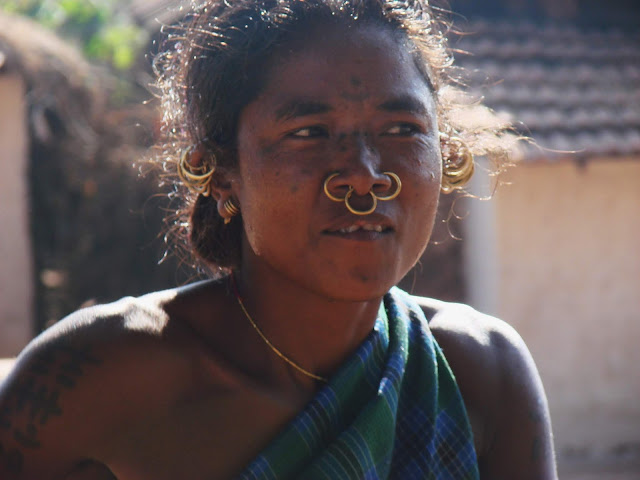 |
| MARRİED WOMAN |
 |
| SO BEAUTİFUL |
 |
| İT STİNKS A BİT AROUND HERE WİTH ALL THİS DRİED FİSH. |
 |
| THE RESTAURANT. HUNGRY ? |
The Niyamgiri Hill range is an area of densely forested hills, deep gorges and cascading streams, home to around 10.000 Dongriya Kondh living in 120 villages situated on its slopes, among which Chatikona. To be a Dongriya Kondh is to farm the hill's fertile slopes, harvest their produce and worship the mountain god Niyam Raja as well as the hills he presides over.
Wood being abundant here, it is stocked for cold days, and tree parts are used to make very resistant rope.
 |
| TAKEN AS SUCH FROM THE TREE |
 |
| AND WEAVED İNTO ROPE |
The village is designed like any Kondh village, on the same pattern as a Desia Kondh village. But due the abundance of wood, the doors and windows are beautifully decorated here.
Dongria women wear three rings in their nose. The first ring is usually offered to a baby girl when she is just one month old. The use of those rings identifies a girl/woman as a Dongria Kondh and wearing them is a matter of pride.
 |
| THE ENTRANCE |
 |
| THE PRİEST AND PEOPLE WAİTİNG TO BE ANOİNTED |
A little further away towards Gopalpur, we see that the road is being repaired. I have always found the women working at those road repairs the most colorful in India, even if most probably they are the poorest and have the hardest of jobs.

And a last stop on the road to Gopalpur, peasants in their fields. Another beautiful sight in India.
Another extremely nice and exciting journey reaches its end. How sad.
I was impressed by the tribal people of Orissa even if the numerous rings around the women's nose and ears, the ornaments around their neck and arms, the saree-like cloth draped around their bodies make them seem of a different land. During this trip I had the impression of not being in India but somewhere else, a totally unknown place.
Then I just remembered that this is ''Incredible India'' and thus the diversified facades of this country are far from imagining.
Far from the glamour of the modern world, the tribal people of India, with their beautiful culture, their vibrant attires, their uncomplicated lifestyle and incredible rituals, depict a different charm of this country, making you love it even more.








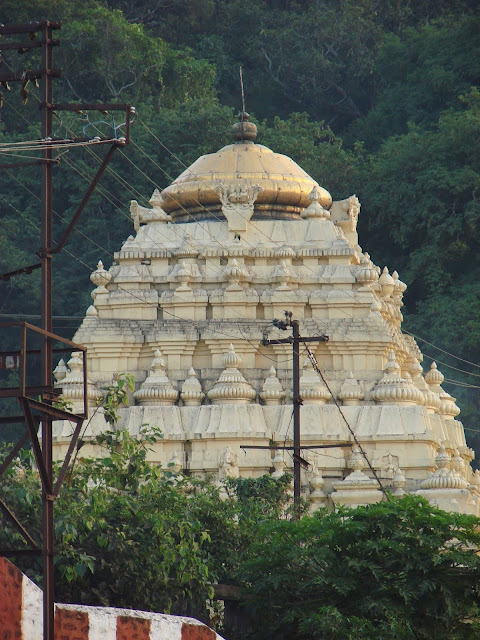

































































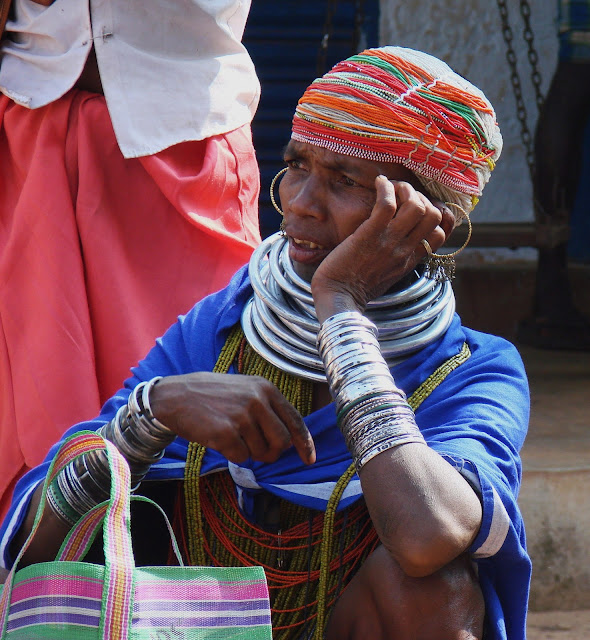

















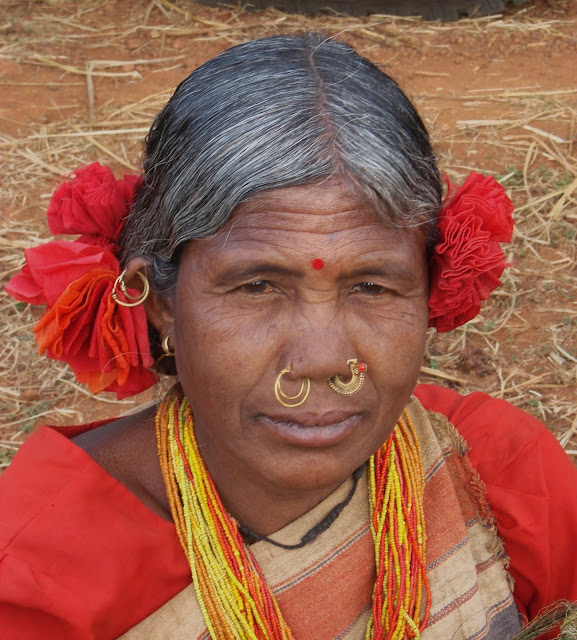














































































































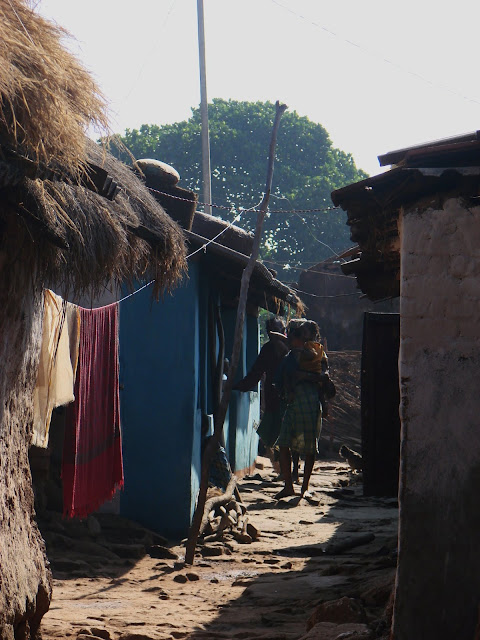

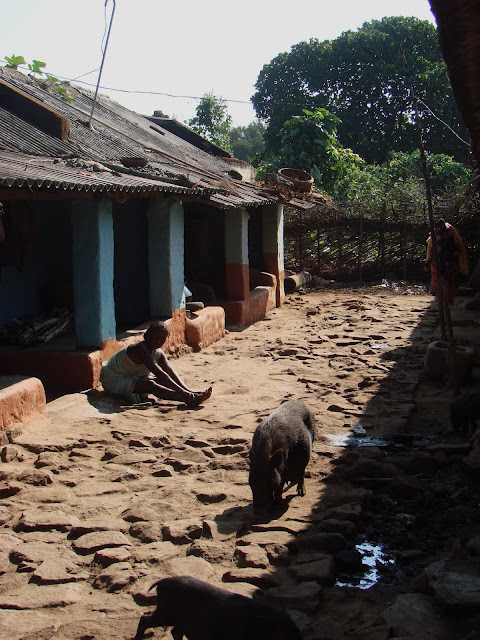

































































































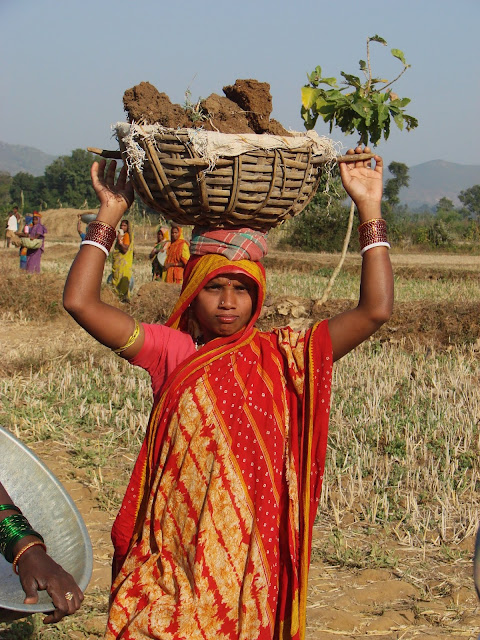








No comments:
Post a Comment